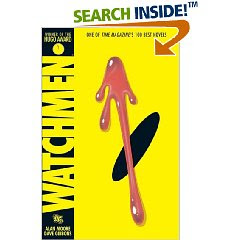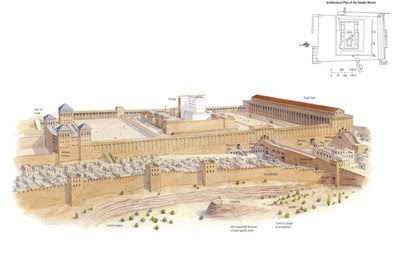For some time my son has been urging me to read the graphic novel ‘Watchmen’. After going and seeing a ‘graphic novel’ of Frank Miller’s on the big screen (i.e. 300), I was intrigued. Dave kept telling me I would find this an exercise in fertility rather than futility. And then we he showed me the teaser preview of the movie Watchmen which will be out next year, I figured it was time to do this. Then I discovered that though this ‘novel’ came out in April 1995, as a compilation of a bunch of DC comics put together in one convenient package, yet this thing is still No. 6 on Amazon, and has been called by a reviewer in Time Magazine one of the 100 most important novels since 1923, I figured I needed to figure out what all the fuss was about. ‘Watchmen’ is the brainchild of Alan Moore (graphic novel writer) and Dave Gibbons (illustrator), both Brits.
Let me offer two caveats from the outset. First of all, there is a certain resemblance between the ‘Watchmen’ in this story to the ‘Watchers’ in much earlier comic stories in Marvel Comics, more specifically in the Fantastic Four stories, among others. But the resemblance is mostly superficial for these ‘Watchmen’ do not simply watch, they act, getting involved in the murky mess of human squabbles. Secondly, I must admit that the psychological depth of characterization in this particular ‘graphic novel’ is light years beyond the somewhat pathos inducing tragic characteristics we see for example in Spiderman or the Thing. And furthermore, this ain’t your DC Comics of my childhood that gave us Mr. Clean (aka Superman).
The graphic novel is just that— graphic. It is an adult comic fiction, and definitely not to be foisted on some unexpecting children– unless you want them to go into counseling quickly thereafter. I would call ‘Watchmen’ an apocalyptic and psychological thriller of sorts, only it is human super-heroes (even if warped and mutated and psychotic), not a divine messiah or God in person that both produces and helps humankind survive beyond Armageddon. This story will not soon be on Saturday morning cartoons. As a graphic novel it pulls no punches— we do not have PC dialogue, we see human beings and even super-human beings with all their foibles and flaws. Even the super-heroes are amoral or sexually immoral, but their remains something of a passion for justice. And therein lies the twist in the tale, for as the Latin quote (see above) from Juvenal’s Satires inquires– if the Watchmen are the world policemen trying to save humanity from its own worst instinct, “who is watching the Watchmen”? The answer does not turn out to be God, nor even a harmless Wizard of Oz figure behind Door Number 3. There is no ‘divine’ intervention in this tale, sooner or later. And so the Watchmen are left to their own devices.
Let’s talk for a moment about the way the plotting of the story works. It is much like watching an episode of “Lost” on TV, indeed one wonders if “Lost” found some of its inspiration in this very novel at least in terms of the way things are structured. We have both flash backs, and flash forwards in this novel though there is a linear and chronological thread pursued from episode to episode in the novel. We also have chapters based on extended tellings of the background of this or that super-hero, some of the previous generation of ‘Minutemen’, some of the current generation of ‘Crimebusters’. The stories are skillfully woven together, and each chapter has an addendum of sorts with some pertinent extra info— excerpts from a book or journal article written by one of the major figures in the story, for example. I imagine the original readers of this in seriatim comicbook form could hardly wait for the next issue to emerge. I much prefer reading it all at once, rather like the way I preferred watching all of Season 4 of Lost all at once. And think of this— one could readily compare Jack and John of Lost, to Adrian and Jon of ‘Watchmen’, but I digress.
One of the things that did most intrigue me was not so much the plot and its resolution, which has been so often commented on at Amazon by multitudinous reviewers that it needs no rehearsing here. It does have interesting twists and turns, not the least of which is its revisionist history— we’ve got Nixon as President well into the 80s— Who Knew?
I was more intrigued by 2-3 of the more complex of the characters– Walter Joseph Kovacs (aka Rorschach), and that exile from the Blue Men group– Jon Osterman, and there are a couple of other real hummers as well. Osterman, whose name means ‘Easterman’ is a person who reassembles himself atomically speaking after falling into a radiation experiment of sorts. It give him incredible powers, such as teleportation. Rorschach is, like the test he is named after, a psychologically damaged litmus figure with a strong passion for justice, righting wrongs, especially the sort he endured as a child, which messed him up. Freud would have a field day with this graphic novel, to say the least.
Osterman is interesting because he is either a predestinarian, or a reasonable facsimile thereof, and he stands in contrast to Adrian Veidt who fancies himself as a sort of Alexander the Great or even a Ramses II sort of world dominator, and like most over-reachers of this sort, he believes in the power of himself.
Listen for example to what he says in a telling interview towards the end of the novel (Chap. XI pp. 8-9 of the addendum): “My mother left me a lot of money when she died, but I gave it to charity when I was seventeen. I wanted to prove that I could accomplish anything I wanted starting from absolutely nothing. Also I wanted to free myself of concern for money. Consequently, its never been a problem for me. To answer your question, you get to be a superhero by believing in the hero within you and summoning him or her forth by an act of will. Believing in yourself and your own potential is the first step to realizing that potential. Alternately, you could do as Jon did: Fall into a nuclear reactor and hope for the best. On the whole I think I prefer to stick to my own methods.” The reporter then responds saying “You’ll forgive me for saying so, but isn’t that philosophy a little Norman Vincent Peale? That self-realization stuff? How exactly do you exploit that potential to the degree that you obviously have?” Veidt responds “The disciplines of physical exercise, meditation, and study aren’t terribly esoteric. The means to attain a capability far beyond that of the so-called ordinary person are within reach of everyone if their desire and their will are strong enough. I have studied science, art, religion, and a hundred different philosophies. Anyone could do as much. By applying what you learn and ordering your thoughts in an intelligent manner it is possible to accomplish almost anything. Possible for the ‘ordinary’ person’. There’s a notion I’d like to see buried: the ordinary person. Ridculous. There is no ordinary person.”
This sounds rather familiarly like various sorts of self-help new age philosophies or post-modern philosophies which are interested in godless self-help spirituality. They stand at the opposite end of the spectrum from the determinism of Jon Osterman. What Moore has skillfully done here is unearthed the psychological pendulum swing when a culture is in an apocalyptic mood or situation. Rejected, at least on the surface is Nietzsche’s ‘Uber-Mensch’ concept, or Ayn Rand’s ‘Few Brilliant persons held down by the hoi polloi’ concept
, and yet ironically the person who is expounding this ‘every-man’ philosophy is in fact Adrian Veidt– the world’s smartest and most successful human!! This is not then a tale of ‘the little engine that could’ or how ‘underdog’ became ‘overcomer’. But it certainly does have the American self-help and pull yourself up by your bootstraps ethos and flavor.
What is most disturbing about this novel from a Christian point of view is not merely its penchant for violence vividly depicted or amorality and immorality, but in fact the despair that undergirds the story in an assumed godless world. You have apocalypse without new earth, Armageddon without New Jerusalem, super-human powers devised by humans without an ability at all to deal with the roots of the problem of human falleness. This may be a novel about a post-Armageddon brave world, but there is nothing ‘new’ about it, and if anything it just punctuates the inanity of violence, and humankind’s inability to save itself, even with super-heroes– “let us save the world and create a lasting peace through destroying a few million people” is the ‘final solution’ offered.
But wait, at the beginning of this novel we were reminded about Hiroshima– haven’t we already gone down that path before, and resolved never to go there again? And did dropping the bomb resolve the human dilemma? NOT SO MUCH. Well perhaps this novel serves as a talisman reminding us that those who do not learn from history are doomed to repeat it. And perhaps as well it reminds us that even our heroes have feet of clay.
Long ago, Daniel had a vision not unlike some aspects of this novel. He foresaw a series of beastly apocalyptic empires each of which rose and fell, and were finally succeeded by one established by ‘one like a son of man’ who came down from heaven, established justice and the kingdom of God on earth. Daniel was telling his audience– the only final solution is indeed divine intervention. As it turns out, it will not be a Jon Osterman who saves the world by self-regeneration. It will be a Jesus Easterman, who will return to judge the quick and the dead and bring in the new heaven and new earth.

